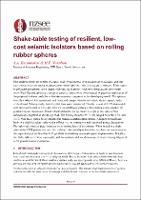Shake-table testing of resilient, low-cost seismic isolators based on rolling rubber spheres

Download
Date
2023-04-19Authors
Katsamakas, Antonios
Vassiliou, Michalis
Metadata
Show full item recordAbstract
This study presents the results of a large-scale experimental investigation of resilient, low-cost seismic isolators based on deformable rubber spheres. The isolators roll on flat or spherical (concave) concrete surfaces. Three different polyurethane spheres were tested, with or without a steel core inside them. A potential application of the proposed isolator could be in low-rise masonry structures in the developing world.
The spheres were initially subjected to monotonic uniaxial compression and sustained compression under vertical load to examine their compressive behavior. Subsequently, a total of 1170 shake-table tests were performed in 1:2 scale, with various different isolators subjected to a large number of ground motion excitations. Different vertical loads were investigated to quantify the influence of the vertical load on the response.
Results showed that the compressive strength of the spheres was substantially higher than the estimated design load. The rolling friction coefficient, that indicates initiation of the rolling motion, ranged between 3.7% and 7.1%. The spherical concrete plates increase the restoring force of the system. When tested in a shake table under 1170 ground motions, the isolators substantially reduced the acceleration transmitted to the superstructure (to less than 0.15 g) while maintaining reasonable peak and zero residual displacements. Notably, the shake table tests were repeatable, and the isolators did not deteriorate even after being subjected to 65 ground motion excitations.
